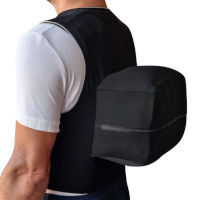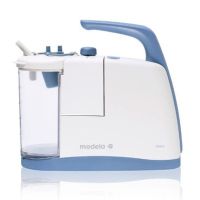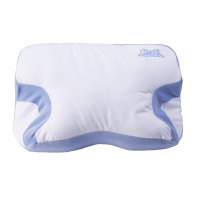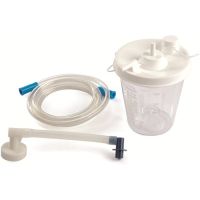secretion aspirators and accessories
If the natural cleansing of the airways through independent coughing is no longer satisfactory, for example after a laryngectomy or in patients with a tracheostomy, these devices suction secretions and substances from the lungs and prevent shortness of breath.
Secretion suction devices consist of a basic electrical device - the suction pump - and the actual suction instrument, which comprises the tube system, secretion container and suction catheter.
The diaphragm pumps used are maintenance-free. Based on the positive displacement principle, the pump draws in air from one side and expels it to the other. The vacuum generated is in a fixed relationship to the mechanical specifications of the pump and can be kept very constant. As the vacuum can be controlled directly via appropriate control devices, any vacuum between 0 Pa and the specified maximum ultimate vacuum can be set. With the help of the vacuum, a connected tube, which is usually extended by suction catheters, can suck the secretion to be removed into a collection container.
The main distinguishing criteria for secretion suction devices are
- Size and weight
- Suction capacity (liters per minute)
- Capacity of the secretion container
- Company via mains / rechargeable battery
Depending on the application, three different device versions are recommended:
- Mains-dependent, electrically operated suction devices are mainly suitable for home use.
- Mains-independent, battery-operated suction devices are ideal for use on the move; they are portable, have a rechargeable battery and are therefore primarily suitable for mobile use.
- Manual suction pumps are designed for emergency use. They do not require a power supply and are operated either by hand or with a foot pedal.
The frequency of the suction requirement and the required suction power (for viscous or liquid secretions) are also decisive for making the right choice.
Secretion suction devices are also available as combination devices that also enable inhalation. After the removal of the larynx or a tracheotomy and thus the loss of the natural moisture retention of the mucous membranes, other precautions must be taken to prevent severe irritation of the mucous membranes. In most cases, such irritation leads to increased secretion, coughing, crusting and bark formation.
know more
Products (17)
-
1 back cushion – breathing treatment
Model: Anti-Schnarch-Weste 2.0 Manufacturer: Nachtwaechter Schlafprodukte GmbH & Co. KG Distributor: Nachtwaechter Schlafprodukte GmbH & Co. KG | Online-Shops -
2 head cushion – breathing treatment
Model: Derila Ergo Manufacturer: Convenity UAB Distributor: Convenity UAB | Online-Shops -
3 suction device – secretion suction device – breathing treatment
Model: Tracheofirst Compact Manufacturer: Andreas Fahl Medizintechnik-Vertrieb GmbH Distributor: Andreas Fahl Medizintechnik-Vertrieb GmbH -
4 head cushion – breathing treatment
Model: Motion Pillow Manufacturer: 10 minds Co. Ltd. Distributor: 10 minds Co. Ltd. -
5 head cushion – breathing treatment
Model: Oxyhero CPAP-Kissen Manufacturer: keine Angaben Distributor: health.On Ventures GmbH -
6 head cushion – breathing treatment
Model: Somnipax CPAP-Kissen Manufacturer: keine Angaben Distributor: health.On Ventures GmbH -
7 suction device – secretion suction device – breathing treatment
Model: Medela Clario AC1 / AC/DC Manufacturer: Medela Medizintechnik GmbH & Co. Handels-KG Distributor: Sanitäts-Fachhandel oder orthopädie-technischer Fachbetrieb -
8 suction device – secretion suction device – breathing treatment
Model: Atemtherapiegerät Alpha 300 IPPB + PSI Manufacturer: keine Angaben Distributor: OxyCare GmbH -
9 suction device – secretion suction device – breathing treatment
Model: Homecaresauger ATMOS LC 27 Manufacturer: ATMOS MedizinTechnik GmbH und Co. KG Distributor: ATMOS MedizinTechnik GmbH und Co. KG -
10 head cushion – breathing treatment
Model: Contour CPAP-Kissen 2.0 Manufacturer: keine Angaben Distributor: health.On Ventures GmbH -
11 suction device – secretion suction device – breathing treatment
Model: Sekretabsauggerät ASSKEA M30Plus Manufacturer: ASSKEA GmbH Distributor: ASSKEA GmbH -
12 suction device – secretion suction device – breathing treatment
Model: ASSKEA proVisio M28 Manufacturer: ASSKEA GmbH Distributor: ASSKEA GmbH -
13 suction device – secretion suction device – breathing treatment
Model: Laerdal Compact Suction Unit LCSU 4 Manufacturer: Laerdal Medical GmbH Distributor: Laerdal Medical GmbH -
14 suction device – secretion suction device – breathing treatment
Model: VENTA SP 26 Komplettgerät Manufacturer: ATMOS MedizinTechnik GmbH und Co. KG Distributor: ATMOS MedizinTechnik GmbH und Co. KG -
15 suction device – secretion suction device – breathing treatment
Model: VacuAide QSU 7314P / 7314D Manufacturer: DeVilbiss Healthcare GmbH Distributor: Börgel GmbH | Sanitäts-Fachhandel oder orthopädie-technischer Fachbetrieb -
16 suction device – secretion suction device – breathing treatment
Model: ATMOS C 261 Aspirator/DDS Manufacturer: ATMOS MedizinTechnik GmbH und Co. KG Distributor: ATMOS MedizinTechnik GmbH und Co. KG -
17 suction device – secretion suction device – breathing treatment
Model: Ratiomed M 20 / Ratiomed M 30 Manufacturer: megro GmbH & Co. KG -Medizinischer Großhandel Distributor: HELPI

















